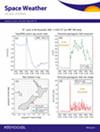Correcting Projection Effects in CMEs Using GCS-Based Large Statistics of Multi-Viewpoint Observations
IF 3.7
2区 地球科学
引用次数: 0
Abstract
This study addresses the limitations of single-viewpoint observations of Coronal Mass Ejections (CMEs) by presenting results from a 3D catalog of 360 CMEs during solar cycle 24, fitted using the Graduated Cylindrical Shell (GCS) model. The data set combines 326 previously analyzed CMEs and 34 newly examined events, categorized by their source regions into active region (AR) eruptions, active prominence (AP) eruptions, and prominence eruptions (PE). Estimates of errors are made using a bootstrapping approach. The findings highlight that the average 3D speed of CMEs is ∼1.3 times greater than the 2D speed. PE CMEs tend to be slow, with an average speed of 432 km s−1. AR and AP speeds are higher, at 723 and 813 km s−1, respectively, with the latter having fewer slow CMEs. The distinctive behavior of AP CMEs is attributed to factors like overlying magnetic field distribution or geometric complexities leading to less accurate GCS fits. A linear fit of projected speed to width gives a gradient of ∼2 km s−1 deg−1, which increases to 5 km s−1 deg−1 when the GCS-fitted ‘true’ parameters are used. Notably, AR CMEs exhibit a high gradient of 7 km s−1 deg−1, while AP CMEs show a gradient of 4 km s−1 deg−1. PE CMEs, however, lack a significant speed-width relationship. We show that fitting multi-viewpoint CME images to a geometrical model such as GCS is important to study the statistical properties of CMEs, and can lead to a deeper insight into CME behavior that is essential for improving future space weather forecasting.利用基于 GCS 的多视点观测大统计校正 CME 的投影效应
本研究针对日冕物质抛射(CMEs)单视角观测的局限性,展示了太阳周期24期间360个CMEs的三维目录结果,并使用渐变圆柱壳(GCS)模型进行了拟合。数据集结合了以前分析过的 326 个 CME 和 34 个新研究的事件,按其来源区域分为活动区爆发 (AR)、活动突出部爆发 (AP) 和突出部爆发 (PE)。采用自举法对误差进行了估计。研究结果表明,CMEs 的平均 3D 速度是 2D 速度的 1.3 倍。PE CME 的速度往往较慢,平均速度为 432 km s-1。AR和AP的速度较高,分别为723和813 km s-1,后者的慢速CME较少。AP CMEs的独特行为可归因于上覆磁场分布或几何复杂性等因素,导致GCS拟合精度较低。投影速度与宽度的线性拟合得出的梯度为∼2 km s-1 deg-1,当使用GCS拟合的 "真实 "参数时,梯度增加到5 km s-1 deg-1。值得注意的是,AR CME 的梯度高达 7 km s-1 deg-1,而 AP CME 的梯度为 4 km s-1 deg-1。然而,PE CME 缺乏明显的速度-宽度关系。我们的研究表明,将多视点 CME 图像拟合到 GCS 等几何模型中对研究 CME 的统计特性非常重要,可以使人们更深入地了解 CME 的行为,这对改进未来的空间天气预报至关重要。
本文章由计算机程序翻译,如有差异,请以英文原文为准。
求助全文
约1分钟内获得全文
求助全文

 求助内容:
求助内容: 应助结果提醒方式:
应助结果提醒方式:


